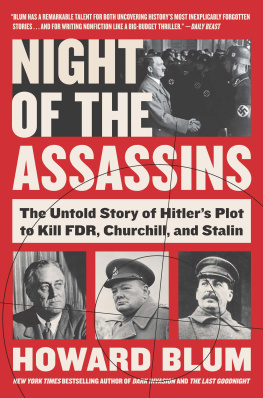Blum - The Last Goodnight: A World War II Story of Espionage, Adventure, and Betrayal
Here you can read online Blum - The Last Goodnight: A World War II Story of Espionage, Adventure, and Betrayal full text of the book (entire story) in english for free. Download pdf and epub, get meaning, cover and reviews about this ebook. year: 2016, publisher: HarperCollins, genre: Non-fiction. Description of the work, (preface) as well as reviews are available. Best literature library LitArk.com created for fans of good reading and offers a wide selection of genres:
Romance novel
Science fiction
Adventure
Detective
Science
History
Home and family
Prose
Art
Politics
Computer
Non-fiction
Religion
Business
Children
Humor
Choose a favorite category and find really read worthwhile books. Enjoy immersion in the world of imagination, feel the emotions of the characters or learn something new for yourself, make an fascinating discovery.
- Book:The Last Goodnight: A World War II Story of Espionage, Adventure, and Betrayal
- Author:
- Publisher:HarperCollins
- Genre:
- Year:2016
- Rating:4 / 5
- Favourites:Add to favourites
- Your mark:
The Last Goodnight: A World War II Story of Espionage, Adventure, and Betrayal: summary, description and annotation
We offer to read an annotation, description, summary or preface (depends on what the author of the book "The Last Goodnight: A World War II Story of Espionage, Adventure, and Betrayal" wrote himself). If you haven't found the necessary information about the book — write in the comments, we will try to find it.
NEW YORK TIMES BESTSELLER
The New York Times bestselling author of the acclaimed Dark Invasion, channels Erik Larson and Ben Macintyre in this riveting biography of Betty Pack, the dazzling American debutante who became an Allied spy during WWII and was hailed by OSS chief General Wild Bill Donovan as the greatest unsung heroine of the war.
Betty Pack was charming, beautiful, and intelligentand she knew it. As an agent for Britains MI-6 and then Americas OSS during World War II, these qualities proved crucial to her success. This is the remarkable story of this Mata Hari from Minnesota (Time) and the passions that ruled her tempestuous lifea life filled with dangerous liaisons and death-defying missions vital to the Allied victory.
For decades, much of Bettys career working for MI-6 and the OSS remained classified. Through access to recently unclassified files, Howard Blum discovers the truth about the attractive blond, codenamed Cynthia, who seduced diplomats and military attachs across the globe in exchange for ciphers and secrets; cracked embassy safes to steal codes; and obtained the Polish notebooks that proved key to Alan Turings success with Operation Ultra.
Beneath Bettys cool, professional determination, Blum reveals a troubled woman conflicted by the very traits that made her successful: her lack of deep emotional connections and her readiness to risk everything. The Last Goodnight is a mesmerizing, provocative, and moving portrait of an exceptional heroine whose undaunted courage helped to save the world.
Blum: author's other books
Who wrote The Last Goodnight: A World War II Story of Espionage, Adventure, and Betrayal? Find out the surname, the name of the author of the book and a list of all author's works by series.



















